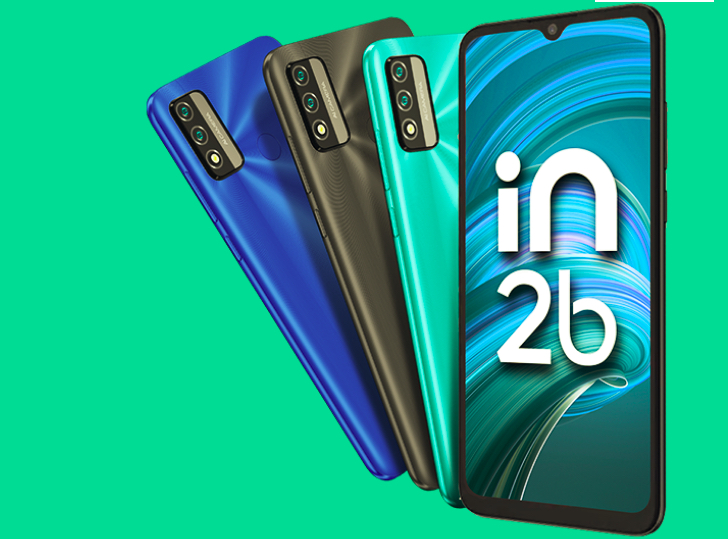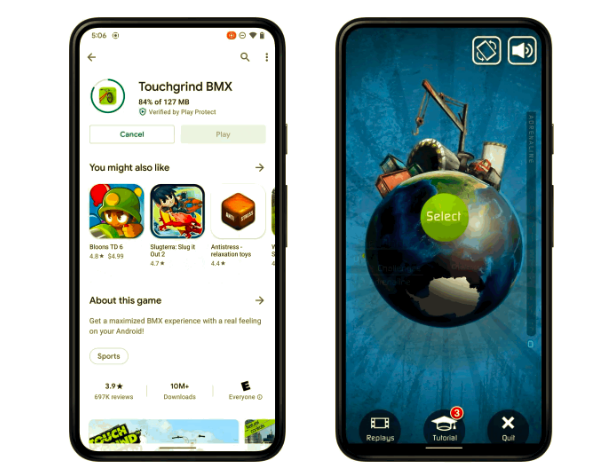Here’s a riddle for you. What’s larger, heavier and contains more plastic than a Samsung Galaxy S4? Answer: a Galaxy S5. Which isn’t a good start for a review, but it’s very definitely not all bad news, don’t worry, the differences are marginal and there’s plenty here to really enjoy in a high-specced gadget. Of course, whether it’s worth upgrading from the trusty Galaxy S4, reviewed here, is another matter – whether you do so is more to do with how much you’ll use the S5’s star feature, its IP67 water-proofing and dust resistance. How active are you really?
Cosmetically, you know more or less what to expect from a Samsung Galaxy – large AMOLED screen (here bumped very slightly to 5.1” but still using diamond pentile technology, though it’s perfectly crisp enough at ‘normal’ screen sizes), physical ‘home’ button (now with gimmicky fingerprint scanner built-in, of which more later) and capacitive ancillary controls.


The Galaxy S5 – familiar, yet subtly different, in hardware and in the TouchWiz UI…
Except that, in a break from Samsung tradition, the menu key has now been replaced by ‘Recent apps’, which mirrors what most of the rest of the Android world has been doing – sometimes with virtual keys, sometimes with physical. Menus are now ‘…’ affairs on-screen, as elsewhere in the ecosystem. This change is jarring for long time Samsung fans, but it makes absolute logical sense and makes it possible now to long press the home key and get Google Now directly, which is much more intuitive than long pressing the menu key.


The Samsung ‘menu’ control, long an anachronism, has finally been jettisoned, in favour of ‘recent apps’…
There are still acres of chrome-effect plastic around the rim, here ridged to make it even more obvious, quite bizarrely – I, for one, am looking forward to Samsung experimenting with other materials for this part of their designs, rumour has it that a premium variant is imminent. About the best that can be said of the ridges here is that they provide more grip than on the flat-sided predecessors.


The side ridges look horrible but they do, in fairness, give more grip….
Happily, the back is still removeable and the battery replaceable, despite the new IP67 (water and dust resistant) rating, thanks to a natty rubber seal around the battery’s profile. As with all removeable components, there’s bound to be a bit of movement after a while though, plus hardening of the rubber, so take the waterproofing with a pinch of salt – it’ll be fine in a shower or if dropped for a few seconds in a toilet but don’t assume you can go scuba-diving with it.


Back off, and the intricate rubber seal shown. Can YOU keep the water out?
Plus you’ll need to have pushed home the back cover all the way round – it’s so easy to leave one clip popped out – and you’ll need to have replaced the new rubber sealed cover for the ever-wider USB 3 port properly too. This remains a bit of a monstrosity – or perhaps curiosity is a better word since Samsung don’t even bother to ship a USB 3 cable in the box – instead you get a standard microUSB cable. Maybe Samsung’s realised that USB 3 was a horrible mistake too? There’s hope for a next-gen USB design that mimics the iPhone’s dual-sided Lightning connector, so this might be the only Galaxy S-class device to be saddled with USB 3 in this form.


The cap-sealed USB 3 port – still a monstrosity in a world in which Apple’s Lightning connector exists, to be honest…
The outer finish on the plastic back has been improved to be grippier and less fingerprint-prone than on the hyperglazed S4, so no complaints from me here. Forget the quippy quotes about the finish resembling elastoplast – it works well, on the gold version here. The S5 is also available in black, (the, apparently, especially nice) blue and white, with – apparently – more colours to come, when Samsung’s marketing deems them necessary to keep sales going.
The increase in size is puzzling. Yes, there are beefier internals to accommodate, plus a battery with totally different aspect ratio, though higher in capacity at 2800mAh, but a trivial 0.1” increase in screen diagonal isn’t really worth a 3mm increase in width and over half a centimetre extra in height. The result is something that’s halfway to the typical Galaxy Note dimensions, yet still pretending to be a traditional smartphone. Maybe the size gain is to do with the waterproofing – or maybe the Galaxy S5 has simply been gorging on Easter eggs?!


The grippy, textured plastic back, with prominent camera island and LED/heart rate sensor opening….
The Galaxy S5 camera
Also larger, though for the better, is the camera, with a 1/2.6” sensor (compare this with the 1/2.3” sensor in the Sony Xperia Z1/Z2 and the huge 1/1.5” unit in the Nokia Lumia 1020). Moreover, a new technology, ISOCELL, is used, effectively separating camera sensor pixels from each other, in an effort to keep down inter-pixel light leakage and general noise. I didn’t see much evidence of noise reduction from this in low light conditions, though the multi-image ‘picture stabilisation’ system worked very well, wherein the best parts of multiple frames (of a static subject) are merged to increase overall quality.


Very low light suburban scene (MUCH darker than it appears here!), stitched together in the multi-image ‘Picture Stabilisation’ mode…
Credit where credit’s due, and the colours and dynamic range in most light conditions with the Galaxy S5 are very good indeed, as you can see the examples here, with the full images at a massive 16 Megapixels. Overkill? Probably. HDR is available in hardware and you even get to preview roughly how such a shot will turn out on the phone screen/viewfinder, which is pretty clever, if you think about it.


HDR example, turning out brilliantly – there’s precisely zero apparent delay during HDR….


Another Galaxy S5 HDR example


The built-in ‘Burst’ facility is great for capturing fast moving things like kids and…. pets!


Gorgeous colours and foolproof high megapixel results in sunlight….


Depth of field effects are easy to achieve optically – no need to fudge it with a special effect if you know what you’re doing…!


Things go a bit pear-shaped when snapping something moving in low light, as here in this party mock-up. But no worse than on other LED-equipped camera phones.
Shot to shot times are excellent, partly thanks to the addition of ‘phase detection focussing’ to the auto-focus arsenal. A gimmicky, multi-shot ‘selective focus’ mode is similar to Nokia’s ‘Refocus’ utility for Windows Phone – and is similarly slow and limited.
Kudos to Samsung for listening to feedback about the ridiculous number of shooting modes in the S4 and S4 Zoom – ‘golf mode’ indeed! Here there are just six main camera modes: ‘Auto’, ‘Beauty face’ (do people really use this?), ‘Shot & more’ (with all the burst mode effects able to be applied after shooting – thank goodness, so less forethought is needed), ‘Panorama’, ‘Virtual tour’ (in which successive photos taken, as directed, are melded into each other, in sequence – think estate agent web sites and you’ll be there), ‘Dual camera’ (again, does anyone care?), plus ‘Download’, where extra camera modes can be grabbed (there’s not a lot here at the moment).
Throughout, the ‘two thumbs’ camera interface was intuitive and pleasant, and even being accosted by a wall of options in the camera app’s Settings wasn’t too off-putting.
Video capture is also very good, at a full 4K if needed, though you have to drop down to 1080p(!) if you want software stabilisation and HDR applied. Audio capture in video mode could have been better, I do wish Samsung would use the same high quality microphones as Apple, Nokia and HTC, for example. [See the video embedded at the end of this review for an included video capture sample.]
Resonating back cover
It’s at this point in most reviews that I comment on a smartphone’s speaker, so crucial for use in speakerphone calls, sat-nav in a car and for YouTube and podcast playback around the home, for example. However, there’s a huge quirk in the use of the rubber seal suspended within the replaceable plastic back cover – it effectively turns the cover into a huge diaphragm, amplifying the bass frequencies from the actual speaker aperture, but providing a very disconcerting vibration should you be holding the Galaxy S5 at the time.


The speaker pours sound into the hollow back cover cavities, which then vibrate the rear of the cover!
I’m assuming that Samsung meant the back cover to be used in this way, acoustically. It’s either inspired design or an appalling kludge and, to be honest, I think both cases could be argued!
Latest TouchWiz experience
Overall, performance is very good on the Galaxy S5, thanks to the 2.5GHz Snapdragon 801 processor and 2GB of RAM, though TouchWiz remains a worry and the UI didn’t feel as amazingly responsive as that on the HTC One (M8). Of the 16GB internal storage, only 9GB is free out of the box (once you’ve let the Samsung applications do their updates), but as usual with Samsung there’s microSD support, enabling up to 128GB extra to be added for media and other resources if needed.
TouchWiz itself seems to have been toned down in two ways. Firstly the application launcher has been completely rewritten, mimicking the Nexus 5’s Google Experience Launcher in some ways, with no wrap around of homescreens when swiping (which is a shame) and with a fixed ‘leftmost’ pane for My Magazine.


My Magazine, a front end for Flipboard, customised for the S5….
This is effectively a tweaked interface for Flipboard, the famous aggregator that started its life back on the Galaxy S3, two years ago. It’s aimed to compete with HTC’s Blinkfeed, but the two are slightly different in scope, with my Magazine being more aimed at browsing through news and HTC’s offering trying to combine this function with more social and Calendar elements. Of the two, I think I prefer Samsung’s more focussed offering (and with the optional social elements turned off, even if it does rather duplicate Google’s Play Newstand, also present on the Galaxy S5. Still, they’re both free.
I was glad to see that the Samsung specific content stores have finally been knocked on the head – no one really used them, I’ll bet, and that some of the Samsung apps (WatchON, Scrapbook, Story Album, S Note, S Translator, Group Play, etc.) are now merely linked to in a ‘Galaxy Essentials’ download area, where users can grab them if they’re needed. A nice way to go.


Gifts and Essentials – something of interest for most people in these two sections/apps…
Also prominent in the default homescreen layout is ‘Galaxy Gifts’, but don’t get too excited, most of the downloads in this section are freeware anyway, which is a bit disingenuous of Samsung.
The standard Android drop down notifications pane has been tweaked slightly for this version of TouchWiz, with S Finder, looking on your device and globally, plus Quick connect, though more immediately dramatic (and controversial) is the overhaul given to the linked Settings hierarchy. Where stock Android has a simple list, TouchWiz has, in recent times, gone with four tabbed lists (to incorporate all the extra Samsung options and functions), but here we have, by default, an icon-ified set of scrolling panes that seem to go on forever. The colours do help get to specifics more quickly once you get used to them, but I can’t claim myself as a fan of the system. Happily, I dug into the Settings within err…. Settings and found the alternative list view shown here, which works far better, I think.


The two different views available for Settings….
Extra sensors and new modes
The extra sensors on the Galaxy S5 are something of a mixed bag. The home button fingerprint scanner is an utter gimmick, working about as well as the scanner on the old Motorola Atrix from three years ago. Which was terrible. Here, my thumbprint was recognised one time in three if I was lucky – you have to power on the screen, then swipe down from the right point at the right speed and at exactly the right angle – else it just doesn’t work. Sorry, Samsung, back to the drawing board.


The swipe-scanner for fingerprints is erratic, at best. Best left turned off.
On the back of the S5 is a rather more useful heart rate sensor LED and detector – no messing with main camera and LED flash here! – tied in with Samsung’s rather excellent S Health suite of fitness aids. Taking a measurement is as simple as putting your index finger tip over the sensor, activating the measurement on-screen with your thumb and waiting five seconds. It’s remarkably accurate for such a short sample time, too.


Getting started with S Health, a pretty comprehensive suite….
If there’s a catch, it’s that the sensor only works well when you’re ‘still and quiet’, which means you can’t be exercising at the time – so you’ve got to stop doing whatever you’re doing in order to take the measurement. Still, for many people’s gym workout regimes, this could be ideal and I was surprised to find myself using it after (and, by stopping, during) each daily power walk.


Using the built-in heart rate monitor…
Brand new for the S5 and sure to be copied by other manufacturers is ‘ultra power saving’ mode, which pulls out every trick in the book to reduce power requirements, right down to black and white UI and deliberately crippling the applications that can be launched. Although, oddly, the Internet browser is still included by default – which instantly brings up a web page’s white background and ensures heavy power drain – I’d remove that facility as part of the ‘ultra power saving’ customisation.


Getting started with ‘Ultra Power Saving’ mode – it works as advertised, though steer clear of white-screened apps on this AMOLED-display device!
Also new (to me) was Kids Mode, 100MB of content which downloads when you first go into this application. As any parent of small kids will know, the question “Can I play a game on your phone?” is a daily occurrence and a daily worry. What will little Johnny find, delete or mess up this time? Happily, Kids Mode solves this problem perfectly, with a sandboxed, PIN-protected environment that’s immune to extra button presses and containing just the games/apps you specify, plus a number of other painting and multimedia kids apps provided by Samsung. As an implementation it’s fabulous – here’s hoping that Samsung rolls this out to other Galaxy models sooner rather than later.


Kids mode is SUPERB. Enough whizzy bits for young kids, links to full games for older children – and zero access to your main smartphone
Wrap up
Who’s the Samsung Galaxy S5 for, then? Probably not for Galaxy S4 owners, for whom the hardware upgrades are, on the whole, minimal (and the extra bulk possibly unwelcome). Galaxy S3 owners coming to the end of a contract will be much more interested, with a massive spec bump and improved grip and durability, plus the much updated TouchWiz refinements.
But unless the IP67 rating is really needed, the preponderance of plastic won’t tempt anyone who’s sampled one of HTC’s recent One models, and it will revolt iPhone owners. However, it’s the ‘latest Galaxy S’, it’ll be pushed to high heaven in phone shops across the world and will sell tens of millions to normal phone users who will be upgrading from ‘mini’ and less expensive devices, for all of whom the Galaxy S5 will be a massive step up.
Five is, of course, a higher number than four, which in turn is greater than three. And, in terms of specs, the Galaxy S range runs along similar lines – the S5 is on the whole, the best device in the series yet and comes with my general recommendation. But, new applications and UI tweaks aside, is it just me who finds the annual upgrades more of a 0.1 bump than a full digit?


















